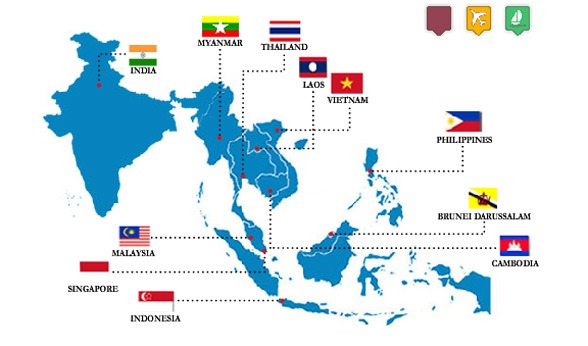Sevinç İrem BALCI
The partnership between India and Association of Southeast Asian Nations (ASEAN) has emerged as a major pillar of the foreign strategy. The relationship has progressed since the early 1990s, when India announced its “Look East Policy,” which led to India becoming an ASEAN Sectoral Partner in 1992, a Dialogue Partner in 1996, and a Summit-level Partner in 2002. The upgrade to Strategic Partnership during the 20th Anniversary Commemorative Summit in New Delhi in 2012 was a natural corollary of the India-ASEAN relationship’s progress over the previous two decades. With the declaration of the “Act-East Policy” during the 12th Summit in 2014, the India-ASEAN Strategic Partnership gained fresh vigor. It expressed India’s strong intention to step up its engagement with the ASEAN Member States.
On June 16-17, 2022, there will be the Special ASEAN-India Foreign Ministers’ Meeting (SAIFMM) in New Delhi. The parts will be discussing on the development of cooperation and evaluate the effects of the Ukrainian War in the global politics. Besides that, the date will mark two major anniversaries — the 30th anniversary of India’s dialogue relations and the 10th anniversary of Strategic Partnership with ASEAN.
India invited the leaders of ASEAN at its annual Republic Day Parade four years ago, in a symbolic move by New Delhi to bolster its ties with the 10-member organization. As India and other nations, such as the United States, strive to counter China’s expanding dominance in the Indo-Pacific region, this endeavor is picking up steam.
Indian External Affairs Minister S. Jaishankar and his Singaporean counterpart Vivian Balakrishnan has stated that, “India and the ASEAN on Thursday agreed to work towards a comprehensive strategic partnership that is meaningful, substantive and mutually-beneficial by further enhancing their strategic ties.” in the meeting.
In addition, Jaishankar emphasized the need of improving land and maritime connections with ASEAN countries. The India-Myanmar-Thailand highway is being upgraded as part of the ASEAN-India Connectivity program. In 2021, trade between India and the ASEAN area was more than $78 billion. Besides, it should be remembered that India is actively improving its major and smaller ports on the east and west coasts as part of its Sagarmala program to create improved infrastructure for greater commerce with ASEAN and is also considering bilateral port-to-port cooperation efforts with Indonesia and Thailand.
The two sides also pledged to strengthen collaboration in the areas of sustainable natural resource management and increased use of renewable, clean, and low-carbon energy, such as offshore wind energy, green hydrogen, smart grid development, and sustainable development.
Saurabh Kumar, Secretary (East), underlined the execution of the ASEAN-India Joint Statement on Cooperation on ASEAN Outlook on Indo-Pacific, highlighting the importance of ASEAN in India’s Indo-Pacific vision (AOIP). This is significant because it will deepen the Strategic Partnership between ASEAN and India.
On the other hand, another significant development happened before the meeting was the participation of Myanmar. At the beginning of the month, India has declared that she will not invite military or political officials of Myanmar to the SAIFMM. However, later New Delhi has sent an invitation to a bureaucrat in the Foreign Ministry of Myanmar. Therefore, it shows that India is willing to see the participation of Nepido to the meeting. Yet, Nepido’s political representative was not allowed to participate in the summit, as well as non-political representative cannot be sent to the meetings. Also, ASEAN was not willing to invite Myanmar to the meeting.
To conclude, ASEAN and India had to cooperate with each other against the escalating position of the great powers in the Asia-Pacific and Indo-Pacific. The two actors had already established good relations before; however, changing dynamics in the international politics forced them to be more integrated. The most significant dynamics are the Russian-Ukrainian War. Also, China has always been a threat in the region. On the other hand, in 2022, the United States has established new strategy on Asia-Indo Pacific including political and economic aspects. Therefore, the two powerful actors of the region must be united.

